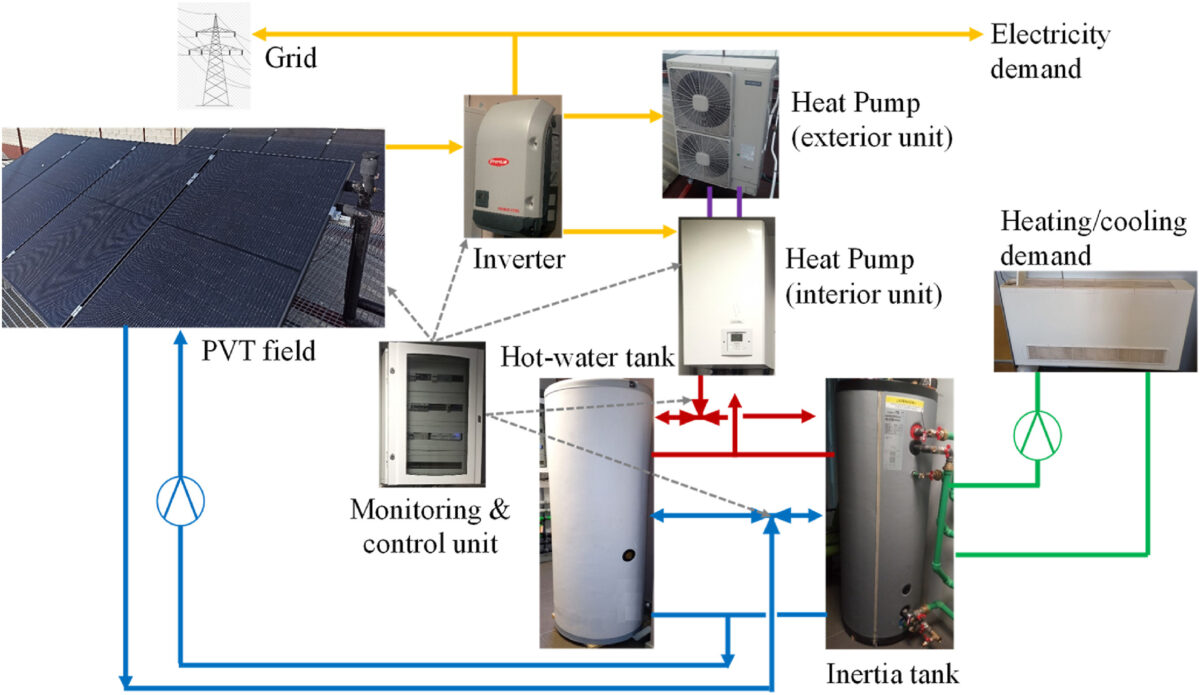Researchers at the University of Zaragoza in Spain have proposed a new design for energy systems based on photovoltaic-thermal (PVT) panels integrated with an air-to-water heat pump via thermal storage tanks.
The system is intended to provide space heating, cooling, domestic hot water (DHW), and electricity to industrial buildings.
“The space heating/cooling distribution circuit uses fan coils as terminal units, allowing a minimum supply temperature of 35 C in winter and 7 C in summer,” they said, describing the operational mode of the system. “To increase the use of low-temperature heat, DHW is supplied at 50 C instead of 60 C, performing periodic heat treatments at 60 C to avoid legionellosis according to sanitary regulations.”
The scientists tested the proposed system design over a 5-month period in a real system deployed at an industrial facility owned by Spanish PVT specialist Endef in Zaragoza. The hybrid pilot plant consists of eight PVT modules with a combined capacity of 2.6 kW covering a surface of 13.6 m2, two water storage tanks with a capacity of 350 l for DHW and 263 l for space heating and cooling, as well as a Yutaki S6 reversible air-to-water heat pump provided by Japanese manufacturer Hitachi.
The heat pump has a nominal capacity of 16 kW in heating mode and of 10.5 kW in cooling mode. Its nominal coefficient of performance (COP) in heating mode is 4.57 and in cooling mode is 3.31. The DHW water tank uses two internal heat exchangers, one for the solar circuit and the other one for the heat pump. The system can provide from 20 C to 60 C in heating mode, from 30 C to 60 C for DHW production, and from 5 C to 22 C in cooling mode.
Popular content
The research team utilized temperature sensors and flow meters to monitor the thermal performance of the system and a DC/AC inverter to analyze that of the PV power generation unit. “Real weather data monitored in the pilot plant is integrated in the model. The transient model is run with a 5-min time-step, and the results shown in this work are averaged every hour to smooth out the results, as otherwise fluctuations obscure the graphical interpretation and comparison of results,” it further explained. “Weekly energy results are also calculated, by integration, to compare weekly performance indicators.”
Through this analysis, the academics found that the system is potentially “overall self-sufficient” to satisfy the building energy demand. They also ascertained that the pilot plant shows negligible deviation from the simulated setting. “The results show that the heat pump COP estimated in the transient model is similar to the one obtained in the pilot plant, with an average error of -10%,” they further explained.
The proposed system is presented in the paper “Experimental validation of a solar system based on hybrid photovoltaic-thermal collectors and a reversible heat pump for the energy provision in non-residential buildings,” published in Renewable and Sustainable Energy Reviews.
This content is protected by copyright and may not be reused. If you want to cooperate with us and would like to reuse some of our content, please contact: editors@pv-magazine.com.



4 comments
By submitting this form you agree to pv magazine using your data for the purposes of publishing your comment.
Your personal data will only be disclosed or otherwise transmitted to third parties for the purposes of spam filtering or if this is necessary for technical maintenance of the website. Any other transfer to third parties will not take place unless this is justified on the basis of applicable data protection regulations or if pv magazine is legally obliged to do so.
You may revoke this consent at any time with effect for the future, in which case your personal data will be deleted immediately. Otherwise, your data will be deleted if pv magazine has processed your request or the purpose of data storage is fulfilled.
Further information on data privacy can be found in our Data Protection Policy.